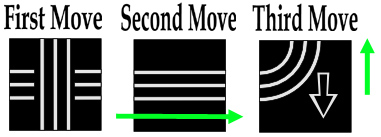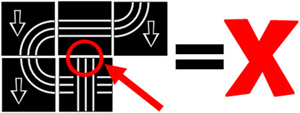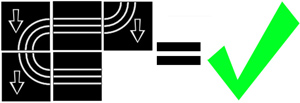Thank you for purchasing Line Dice, a quick and simple dice game for 2 to 6 players, ages 5 and up. The Line Dice is a winding, single, unbroken path you follow until you can't go any further. If you can't play on your turn, you lose. The last player to continue on the path is the winner. Beginning a game:
Starting Out:
First dividing up all of the dice evenly amongst all the players:
2 Players = 18 Dice each
3 Players = 12 Dice each
4 Players = 9 Dice each
5 Players = 7 Dice each - (Roll the remaining die and it becomes the First Move)
6 Players = 6 Dice each
For a quick match, try limiting the number of dice to 10 for each player.
Each player shakes up their dice and rolls them publicly. This determines the moves available to each player. Once rolled, the dice can not be re-rolled! If you can not play any of your rolled moves, you lose. You can hide your dice after the roll to prevent other players from strategizing your moves.
There are 3 types of Dice Faces:
The Straight Line:

The Cross:

The Cross piece is like an Overpass on a Freeway. It's not a 4-Way Stop. Those 2 sections of road do NOT directly connect.
And 4 Corners:

The Corners are differentiated from each other by an Arrow in one corner of the each face. This shows you the direction the Corner must face during gameplay. Each player should take a moment to align all of the Corners rolled so the Arrows all face the same direction. It helps to keep the game moving smoothly.
Pick who goes first: Paper-Scissors-Rock, Flip a Coin, or Oldest goes first.
Game Play:
First Move:
The First player can play any dice they like. I use a Cross the for example, but any piece (Straight, Corner, or Cross) can be used. Place the dice in the center of the table to allow the most room to build off of.
The Corner Arrows:
When the first Corner is played, the direction of all further Corner Arrows MUST face the same direction. After the first Corner piece is played, all players are encouraged turn their Corner dice so all of the arrows face the same direction as the first Corner played. Once turned, it's easier to plan your moves. Experienced players also tend to group Corners by Arrow direction, so they can plan out their moves better.
Path of Travel:
The second dice placed determines the Path of Travel. You are always moving FORWARD at all times, never backwards. Think of the Path of Travel like a car hurdling down a highway. The first dice is where it started, and the second dice shows you the direction on the Road you are heading. The dice after that continues the road. The Road can only continue forward, NEVER back! When you come to Cross piece, you treat it like an overpass. You continue either over or under the perpendicular road, but can NEVER turn Right or Left onto it. Like an Overpass, the Cross piece contains 2 completely separate roads that never touch each other.
Remember: At NO TIME can you turn around and use the other end of the road! You must continue forward until you, or the other players, run out of usable Road.
Don't confuse the Path of Travel with the Arrows on the Corners, which exist only to give you can idea of which way each Corner should face. You can travel against Arrows or with them, but you can ONLY move forward every move.
Each player adds one dice to the front of the Road, then passes turn to the player on their Left.
Here's an example of 3 Players, each playing one dice, during each of their first turns:

The first player plays a Cross, so the direction of all Corners is unknown, as is the Path of Travel.
The second player plays a straight line. By playing the line on the Right, the second player has established the Path of Travel, demonstrated here in green. All further moves have to continue in the direction set by the second player. The direction of all Corners is still unset.
The third player finally plays a Corner, and now all future Corners played have to be rotated so their arrows all face in the same direction. As you can see by the last green pointer, the next piece has to be played at the top of Player 3's Corner, continuing the Line upwards.
Here's an example of how that game might continue to be played. As you can see, the Arrows on all of the Corners are facing Down, because the first Corner to be played had it's Arrow facing Down. The 6th move is the 2nd Cross, which is eventually passed through again after the 9th move. Following the 9th move, 10th move appears again on the other side of the 2nd Cross. The 11th move is the 3rd Cross. The Road loops around again, eventually diving through the 3rd Cross and appearing with the 15th move on the other side. This example stops with the 16th move, which would have forced the 17th move to dived under the 1st Cross, and appeared at the bottom it to continue the game.

True Lines:
All Lines must remain "True". You can not play a Cross Dice adjacent to a non-connecting Straight or Corner piece, nor can you “dead-end” a Corner or Straight piece into the edge of an unsupported die. True Line Examples:


Most IMPORTANT: If you don't have a move to play, you LOSE! No passing turn, you either have something to play your turn or you're out.
Victory Conditions
Last Man Standing:
If you are the last player, even if you don't have any playable moves left, you are still the Winner by Default.
Sabotaging the Board:
You can win by making it impossible for any other player to play any dice. Because everyone else loses before the turn returns to you, you Win by being the Last Loser.
Closing Infinity:
You can also win the game by forcing the very next player to play a move that connects the line back to the starting move of the game, effectively making an infinite loop and destroying the game. When an infinite Line is made, the player BEFORE the player that made the infinite path is the winner, not the player who made the infinite Line. If I make you form an Infinity, I win, not you.
Optional Rule
Mike's Bluff:
Let's assume you've run out of legitimate moves and you're about to lose the game. You can *attempt* to put in a corner dice facing the wrong way. If the next player plays a dice without calling out your bluff, then your wrong facing corner becomes a legitimate move. We like to consider it "Honest Cheating". If you get called out for your misplaced dice before the next player plays, punishment is recommended.
Game Winning Strategies:
Since these have large animated GIF's showing how to do them, I've moved this section to it's own set of Subpages:
Others soon to come!
(Do you know of some? Be a good egg and share your tips with the world. Otherwise we'll all get mad and stop playing with you!)